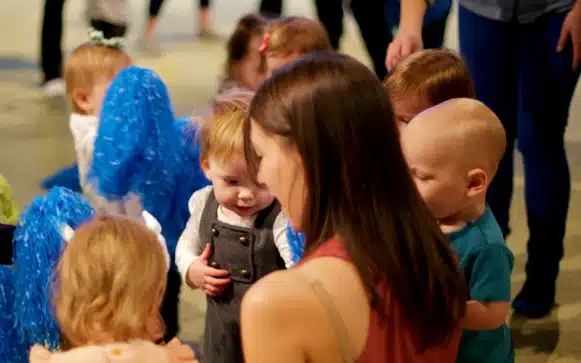Toddler biting is in fact a normal stage of development, yet as a parent, I was horrified when my daughter sunk her teeth into her playmates arm during class. I did not want her to be labeled as “the biter,” especially because she wasn’t an overly assertive toddler nor was her behavior malicious. Still, I knew I needed to understand why she was biting and respond to it before it did become a habit.
There are a number of reasons why children bite:
(1) Teething Pain: Young babies will bite anything just to relieve the pain of the their tender gums as they teeth.
(2) Exploring their environment: The mouth is one of baby’s first senses! It is very common for them to put anything and everything into their mouths as a way of exploring their environment.
(3) Attention: Children look for reactions to their behavior — “what response will this action provoke and will I in return receive attention?” I have found that children also tend to hit to receive attention and/or to express themselves.
(4) Imitation: Children love to imitate other children. Your child may immediately imitate what he/she witnessed (a frustrated playmate shoving mom when it’s time to leave) or store it away until he/she is placed in a similar situation.
It is NEVER a good idea for an adult to bite a child back to teach a lesson. He/She does not understand the double meaning and will continue to believe that such behavior is acceptable.
(5) Independence: Children work very hard to show their independence. Toddler biting, although inappropriate, is a way for them to communicate their need to control the situation, or to communicate that they have power over others and the situation.
(6) Frustration: Toddlers are still learning how to own their body movement and strength. Their intention to give a loving hug may take the form of a body tackle. They also aren’t able to use words to communicate their needs and feelings. In their frustration, toddler biting, pushing or hitting can occur. Becca Drew Emmerich lends a 3-step process when dealing with pushing.
(7) Stress: Just like adults, children have to cope with the stress of growing up. Whether they missed their nap, their routine changed, and/or something disrupted their normal environment, toddlers may bite as a means to deal with stress.
Ways I curbed my daughter’s biting habit:
- I began to look for things that might be triggering my daughter to bite. In her case, she tended to bite when she was trying to assert herself when playing with certain children. Vigilance was the answer.
- When she was playing in certain environments, when she did show signs of frustration, and when she began to clench her teeth, I was quick to remove her from the situation to a quiet spot. I shared with her right then and there that it was not alright to bite our friends, and that it hurts.
- In our situation, it was clear that my daughter was trying to express herself, but didn’t have the words to do it, so I taught her the sign for stop. I also reminded her that if she was in a situation that she didn’t like, she should come find me or her teacher to help her.
Nipping the biting habit in the classroom:
(1) Biting to show affection: As a teacher, I have also witnessed children bite to show affection. While clearly meaning to go in for a kiss, it ends up being a bite instead. Of course, they mean absolutely no harm, and they are just expressing affection. Reiterate soft hugs as a way to say hello, thank you, good-bye and “I love you.”
(2) Biting to receive attention: The trickiest toddler biting to deal with is when a child is on a quest for attention. I’ve noticed this happens more often with children whose mother is pregnant or with the birth of a new sibling, as they can mistakenly feel as if they are losing their place.
- The most important thing as a teacher, parent or caregiver is to be vigilant. If you are aware that the child has been biting, it is crucial that you pay close attention to him/her and that you are there to stop the behavior before it happens.
- A time out and an explanation of why it is wrong to bite is in order, but if the behavior continues, it is best to quickly remove your child and give a firm “no.” Be clear with him/her that this is not a productive way to gain attention.
(3) Show the other child sympathy: It also is important that the parent, teacher or caregiver show the “bitten” sympathy. Parents will appreciate that you are handling the problem, and it sends a strong message to the child who was the aggressor, that this is not the right way to go about getting attention.
(4) Praise good behavior: Give specific praise when you see good behavior, such as “You are playing so gently with your classmates. Wonderful job!” Be quick to verbally recognize good or changed behavior.
(5) Easier said than done: As a parent, I know this can be difficult, and that it may take time to correct the behavior. It is always easier said than done and it does take persistence. If it doesn’t work the first time, don’t give up, be consistent and persistent with your actions. Whatever you do, realize that you need to stick with it. If you give up, you are sending a message to your child that their behavior is excusable and they will continue to bite.
(6) Be Positive: As parents we are quick to say “don’t do this or that.” Young children have a difficult time understanding this as they begin to explore their world. You will get a much better response from them if you show them how to correct their behavior.
Don’t make the mistake that we all have as parents — continue to give warnings in a raised voice. Keep it simple, remove them from the situation, remain calm and show your child positive behavior.
How did you break the toddler biting habit? Share with Kim your action steps, stories and questions below and @BubblesAcademy.

Kim Schiefelbein
Kim Schiefelbein is the Senior Director of Music and Community Programming at Bubbles Academy. Kim leads the development and teaching of the music curriculum and partners with Neighborhood Parents Network to present their Chicago School Choice workshops. A certified fitness instructor, Kim also leads the Stroller Fitness program.
